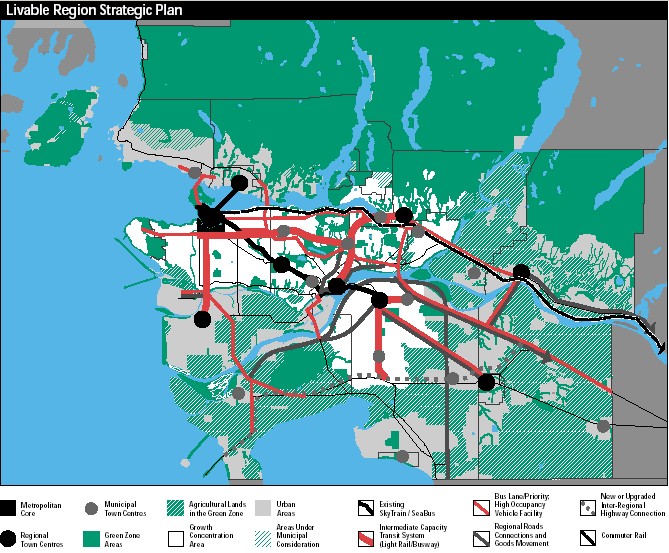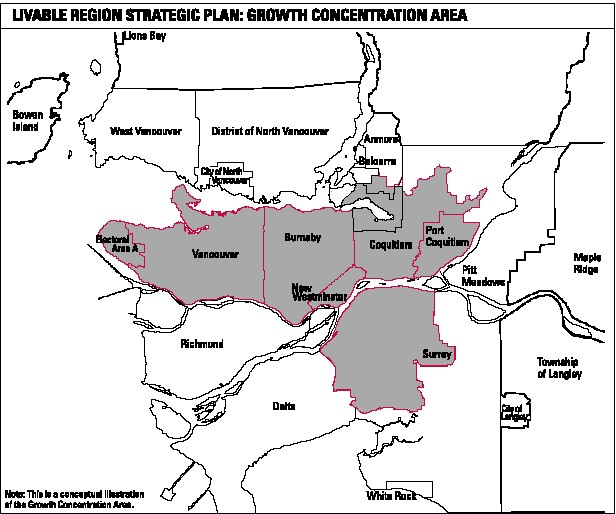Greater Vancouver Regional Sustainability Initiatives.
Greater Vancouver’s
Population Growth Rate of 2.6% has rivaled rates of many 'Third World'
mega-cities (Northwest Environmental Watch, 2002). This immense growth,
concentrated largely in the cities of Surrey and Vancouver, coupled with
increasing public concern over environmental degradation and a renewed interest
in ‘community’ and ‘civicness’, has put pressure on municipal governments
and the GVRD to adopt strategies for managing growth in the region sustainabley.
A culmination of several decades of regional strategies for managing growth
in the region, the LRSP is a regional strategy for managing growth “based
on a concept of sustainability that encompasses economic, social, and environmental
dimensions” (GVRD 2001). A new GVRD initiative, the Sustainable Region Initiative
(SRI), is a review of the LRSP that builds on its guiding principles and
objectives to “bring forward the foundation for a more fully integrated
set of plans for the region” (GVRD, 2001; 8). The SRI is not a single-purpose
plan or strategy, but a conceptual framework or a management philosophy
that that is intended to determine how plans and strategies will be developed,
adopted, implemented, and evaluated.
The regions strategies for growth
managements as established in both the LRSP and the SRI rests on four fundamental
objectives: Protect the Green Zone; Build Complete Communities; Achieve a
Compact Metropolitan Region; and Increase Transportation Choice. The Green
Zone makes up approximately one-third the total land area of the GVRD, protecting
Greater Vancouver’s natural assets including watersheds and resource lands
while setting a long-term boundary for urban growth. The agricultural land
reserve (ALR) is the largest chunk of the Green Zone, protected by the Agricultural
Land Reserve Act.

Under the objectives
of building ‘complete communities’, the LRSP contains a policy stating that
the GVRD will “seek through partnerships a diversity of housing types,
tenures and costs in each part of the region” (GVRD, 1996;14). The GVRD
bases its “complete communities” strategy on the LRSP network of regional
and municipal town centers, “which are intended to be primary concentrations
of jobs, housing, culture, and recreation opportunities. The chosen network
reflects and reinforces established centres, and defines some of the emerging
centres that will be increasingly important in the future” (GVRD, 1996;11).
Major centres that have been designated by the GVRD include the metropolitan
core (Downtown Vancouver and Central Broadway), Coquitlam Town Center, Downtown
New Westminster, Metro Town, and Surrey City Center. The LRSP’s ‘complete
community’ policies “support economic growth by promoting an equitable distribution
of jobs in balanced communities, private sector investment in town centres,
and investment in the regional transportation system” (ibid).
The ‘Achieving A Compact Metropolitan
Region’ policy calls for concentrating residential growth in the region
in its core municipalities, which the LRSP has designated as the regions
“Growth Concentration Area (GCA)”. The GCA is a very large area, consisting
of the Burrard Peninsula (Vancouver, UBC and environs, Burnaby, and New
Westminster), the Northeast Sector (Coquitlam, Port Coquitlam, Port Moody,
and Anmore), and North Surrey/North Delta. The GCA includes the current
central urbanized core of the region, plus two major sub-regions that are
expected to make the transition from suburban to urban form within the life
of the plan. Policy targets are for approximately 70 per cent of the total
regional population and employment to reside within the GCA. As of 2000,
an estimated 68 per cent of the population resided within the GCA. Growth
Concentration policies in the LRSP “help ensure that an improved regional
public transit network is provided with enough potential riders to justify
the public expenditure” (GVRD, 2001; 26). As part of its strategy for
achieving a compact metropolitan region, the GVRD board will “seek through
partnerships …the achievement of adequate population and employment densities
in centres and transportation corridors to support planned transit services”
(GVRD, 1996; II-22). Although the LRSP does not specify what these adequate
population and employment densities are, Translink’s 1999 Strategic Plan
Discussion Paper states that “it is not until cities reach an aggregate density
perhaps in the range of 10 to 12 dwelling units per acre that the percentage
of travel by transit is able to break out of being in the single digits…”(28).
The LRSP provides targets for household and population growth for individual
municipalities that includes estimated capacities as well (GVRD, 1996).

The last main
objective of the LRSP is to “Increase Transportation Choices” by implementing
a transit-oriented and automobile restrained transportation system. “This
is to be achieved through an increase in transit supply, a moderate increase
in roads especially to accommodate goods movement, and through trip reduction
strategies” (GVRD, 2001; 27). The increase in transit services was to be
focused on bus services. The LRSP establishes a commuter mode split of
18 percent as a transit target by 2001. In 1999, the provincial government
transferred responsibility for regional transportation services to the Greater
Vancouver Transportation Authority (GVTA), which created the Strategic Transportation
Plan (STP) that was endorsed by both the GVRD and the GVTA in 2000. Approximately
75 per cent of the STP’s five year budget (an approximate $1 billion expenditure)
was to be dedicated to transit improvements and to be funded by transit
fare increases, as well as a vehicle levy in addition to the current STA
funding sources, the majority of which comes from a provincial fuel tax
dedication of 10 cents a litre. Although transit fare increases were implemented,
the vehicle levy was not, and many of the transit improvements were put
on hold, and some existing transit services cut. The STP has allocated
$330 million for improvements and additions to the major road network from
2000-2005 (GVRD, 2001; 51).
The four fundamental objectives
of the LRSP and the SRI are based more or less on the transit village and
transit oriented development concepts. In addition, they express an understanding
of the importance that integrated land-use and transportation decisions
make in achieving sustainability. However, equally crucial to understanding
what has to be done is knowing how it is to be achieved and having in place
an effectively regulated implementation strategy for achieving it. Summarized
below is the regional strategy for implementing the LRSP made up of the
four fundamental objectives described above.
Next Page
Home

